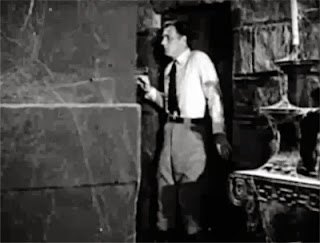If the anomaly takes place within a world where the cognitive order rules, and where affectivity is indeed the tail wagged by the dog, then the narrative’s phenomenality is “atypical.”I now intend to bring this in line with Cassirer's observations re: the distinctions of the "causality" concepts characteristic of empirical thought versus the "multicausal" concepts characteristic of mythical thought, especially as conveyed through what Cassirer calls the opposing conception of causality, "magical efficacy."
If it takes place within a world that breaks with the cognitive order, in which causs-and-effect is in some way suspended, then the phenomality is “marvelous,” and the affectivity produced is one that also strives to go beyond the cognitive order.
If the work seems to suggest that the cognitive order is violated, when in fact it is not, its phenomenality will be “uncanny” as long as the work succeeds in evoking an affectivity that symbolically exceeds the cognitive order.
Thus a Cassirer-based reconfiguration reads thus:
NATURALISTIC-- cognitivity and affectivity are defined by the causal order; i.e. "one definite cause yields one definite effect"
UNCANNY-- cognitivity is defined by the causal order, but affectivity exceeds causal order and participates in the multicausal nature of "efficacy"
MARVELOUS-- both cognitivity and affectivity exceed the causal order and participate in the multicausal nature of "efficacy"
The nature of affectivity in each phenomenality is logically glossed by the antipathetic and sympathetic affects I've detailed on the blog, each of which form a triunity. The negative affects-- fear, dread, and awe-- were formulated by Rudolf Otto in THE IDEA OF THE HOLY, schematized by C.S. Lewis in THE PROBLEM OF PAIN, and first examined on this blog in this essay.
Because I felt neither Otto nor Lewis had adequately defined a set of corresponding positive affects, I supplied a corresponding triunity in this essay. Shortly later, I revised one of the three terms in this essay, so that my corresponding set of sympathetic affects now sport the names of "admiration" (the counterpart to "fear"), "fascination" (the counterpart to "dread"), and "exaltation" (the counterpart to "awe" of the abysmal type described by Otto).
Therefore affectivity in the three phenomenalities can be aligned thusly:
In a fictive world where affectivity is defined by the causal order, the dominant sympathetic affect is "admiration" of things characteristic of the causal order, particularly what Jung called Freud's "physiological factors," while the dominant antipathetic affect is "fear" of aspects of the causal/physical order.
Where affectivity exceeds the causal order in accordance with the multicausal nature of the world's cognitivity, the dominant sympathetic affect is "exaltation" toward the multicausal, and the dominant antipathetic affect is "awe" toward it.
It's easy to descry affects of admiration and fear in naturalistic works, or affects of exalatation and awe in marvelous works. The uncanny, however, is harder to demonstrate, precisely because the causal order rules the cognitive aspect of the uncanny work, causing many viewers-- like Todorov-- to mistake it for the purely naturalistic. Instead, the uncanny flourishes precisely in the contrast between the monocausal nature of cognitive reality in a given work, while affectivity "symbolically exceeds the cognitive order," taking the dominant forms of "fascination" for the sympathetic affect and "dread" for the antipathetic affect.
None of this means that affects most characteristic of one phenomenality cannot occur in another phenomenality, but those affects are not characteristic. As a quick example, the little remembered adventure-serial ACE DRUMMOND-- reviewed here-- imperils its hero with threats that are, at varying times, naturalistic, uncanny, or marvelous, and all controlled by the serial's villain, "the Dragon."
If the villain had only been able to threaten Drummond with mundane guards, then the phenomenality of the serial would have been naturalistic, and its dominant antipathetic affect would be fear.
If the villain had been able to threaten Drummond with both his mundane guards and his "Room-with-Crushing-Walls," then the presence of the latter threat would trump the naturalistic elements and change the phenomenality to the uncanny, so that even though the affect of 'fear" still existed with respect to Drummond's battle with mundane guards, "dread" of a villain able to control a weird weapon like a '"crushing room" would make "dread" the dominant antipathetic affect.
However, as things stand, the evil Dragon could menace Drummond and his buddies with the previously cited threats and a marvelous death-ray device as well-- and indeed, the death ray gets the most narrative attention in this particular serial. Thus the dominant antipathetic affect, overruling those of "fear" and "dread," is one of "awe" before the villain's marvelous resources.
I will enlarge on these observations in Part 2.



No comments:
Post a Comment